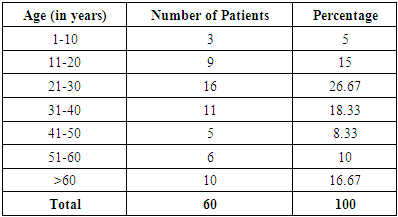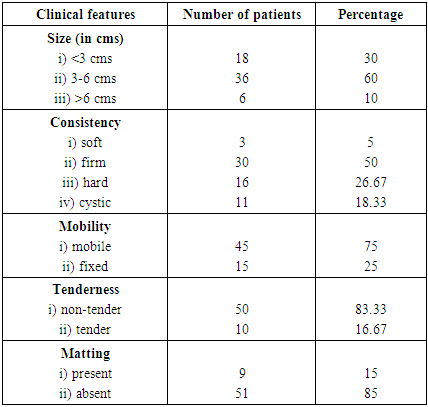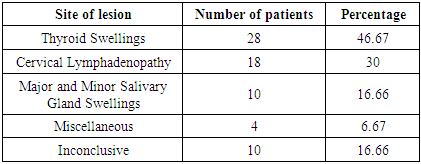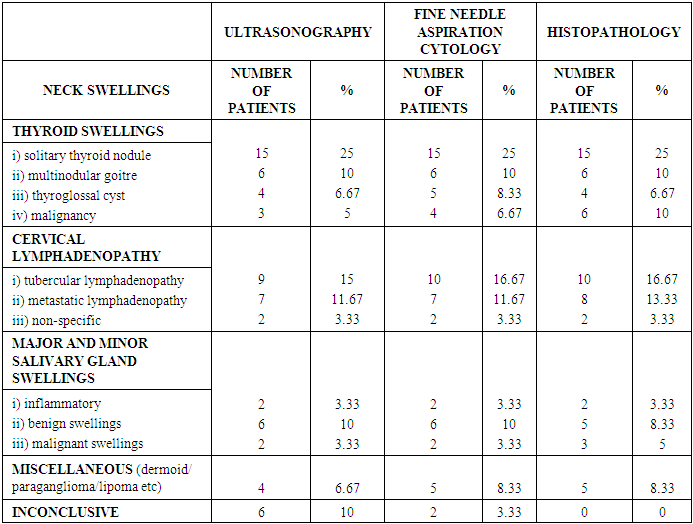-
Paper Information
- Paper Submission
-
Journal Information
- About This Journal
- Editorial Board
- Current Issue
- Archive
- Author Guidelines
- Contact Us
Research in Otolaryngology
p-ISSN: 2326-1307 e-ISSN: 2326-1323
2019; 8(1): 1-5
doi:10.5923/j.otolaryn.20190801.01

The Role of Ultrasonography and Fine Needle Aspiration Cytology in the Diagnosis of Neck Swellings - Our Experience
Afshan Fathima, Shubhi Tyagi, Borlingegowda Viswanatha
Department of ENT, Bangalore Medical College and Research Institute, Bangalore, India
Correspondence to: Borlingegowda Viswanatha, Department of ENT, Bangalore Medical College and Research Institute, Bangalore, India.
| Email: |  |
Copyright © 2019 The Author(s). Published by Scientific & Academic Publishing.
This work is licensed under the Creative Commons Attribution International License (CC BY).
http://creativecommons.org/licenses/by/4.0/

Introduction: Palpable masses in the head and neck region can arise from various structures such as thyroid gland, lymph nodes, salivary glands, soft tissues, blood vessels and neural structures. Evaluation of these swellings clinically, sonologically and cytologically increases the probability of making the correct diagnosis and planning the appropriate management. Materials & Methods: The present study was carried out between February 2018 and January 2019. 60 consecutive patients with neck swellings attending the outpatient department of ENT, Bangalore Medical College & Research Institute, Bangalore were included in the present study. The study population was clinically evaluated in the outpatient department followed by subjecting them to ultrasonography (USG) and fine needle aspiration cytology (FNAC) of the neck swelling. The results were tabulated and correlated in terms of age, gender, frequency of occurrence, and the anatomical location. The sensitivity, specificity and accuracy of USG and FNAC was evaluated. Results: The most common neck swelling in the present study was thyroid swellings (51.67%). This was followed by cervical lymphadenopathy (33.33%). The final diagnosis was made by histopathology. The swellings were evaluated clinically, sonologically & cytologically. In our study, USG was 87.20% sensitive, 78.15% specific, positive predictive value (PPV) of 85.42%, negative predictive value of 80.50% and accuracy of 78.33%. FNAC showed a sensitivity of 93.67%, specificity of 88.80%, positive predictive value (PPV) of 91.62%, negative predictive value (NPV) of 89.23% and an accuracy of 88.23%. Conclusion: Neck swellings are encountered more frequently by surgeons in their day to day practise. These swellings can arise from various structures in the neck. A thorough evaluation of these neck swellings is mandated. Though histopathology remains the gold standard in arriving at a diagnosis, evaluation of these swellings on a clinical, USG and FNAC basis gives a comprehensive understanding of the nature of these swellings and helps the surgeons in their better management. Using all three i.e. clinically, USG and FNAC in the evaluation of neck swellings will help in better diagnosis and decision making for need of surgery.
Keywords: Neck swellings, Ultrasonography, Fine needle aspiration cytology
Cite this paper: Afshan Fathima, Shubhi Tyagi, Borlingegowda Viswanatha, The Role of Ultrasonography and Fine Needle Aspiration Cytology in the Diagnosis of Neck Swellings - Our Experience, Research in Otolaryngology, Vol. 8 No. 1, 2019, pp. 1-5. doi: 10.5923/j.otolaryn.20190801.01.
1. Introduction
- Neck swellings are frequently encountered by surgeons in the day to day practice. The swellings can arise from various structures in the neck such as the thyroid gland, major and minor salivary glands, lymph nodes, soft tissues, blood vessels and neural structures adding to the ambiguity of the diagnosis. These swellings can present as inflammatory or non-inflammatory lesions. The age and gender of the patient, location, size, onset, duration and progression of the swelling gives important clues in making the differential diagnosis from the clinical point of view.Neck sonography was first introduced in 1966-1967 [1]. It has been widely practiced since the 1970 and is now one of the most popular radiological methods of diagnosing neck disease [2]. Sonography is commonly the first imaging modality after clinical examination. It is an easily accessible, non-invasive way to image the neck mass and its pathology. It helps to pin point a possible abnormality at an early stage and includes the elements of differential diagnosis that result in subsequent thorough examination and timely treatment in appropriate cases. On the basis of the sonographic findings selection of additional imaging modalities including CT and MRI of neck can be applied more judiciously.The diagnosis of neck lesions using aspiration cytology was first reported by Martin & Ellis in 1930 [3]. The routine use of fine needle aspiration cytology (FNAC) in the assessment of thyroid nodules has reduced the number of patients subjected to thyroidectomy for benign diseases of the thyroid [4-6]. However, the success of FNAC is contingent upon several important contributing factors including aspirator experience [7-9], skilful cytological interpretation and a rational analysis based upon a synthesis of cytological and clinical information in the context of an individual patient [8, 9].Evaluation of the neck mass must be approached in a thorough and disciplined manner [10]. Especially in the adult population, these masses can present as the only manifestation of a serious and potentially malignant pathology. The common pathologies are usually from enlargement of lymph nodes (lymphoproliferative disorders, inflammatory process or infiltration by metastatic malignant cells), thyroid gland (goitre, thyroiditis, benign and malignant tumours), salivary glands (sialadinitis, cysts, benign and malignant tumours) and various other lesions like thyroglossal cyst, epidermoid cyst, dermoid cyst, lipoma etc. Neoplasia makes a significant differential diagnostic consideration because neck mass is often the first and sole presentation of the metastatic process. It also helps in detecting recurrences or emergence of new tumours after treatment, obviating the need for surgical intervention in most cases.Hence there is a need to evaluate the neck masses thoroughly in order to make an accurate diagnosis which helps in planning the further line of treatment.Aims & Objectives:1) To classify the neck swellings based on anatomical sites, age group, gender and nature of lesion.2) To evaluate the neck swellings based on clinical, sonological and cytological findings.
2. Materials & Methods
- The present study was carried out in the department of ENT, Bangalore Medical College & Research Institute, Bangalore between February 2018 and January 2019.Sample size: 60 patientsMode of selection: 60 consecutive patients presenting with clinically palpable neck swellings, to our outpatient department of ENT, were selected for the present study.Inclusion criteria: Patients consenting for the study, clinically palpable neck swellings, patients willing to undergo ultrasonography (USG) and fine needle aspiration cytology (FNAC) of the neck swellings.Exclusion criteria: Patients with clinically undetectable neck swellings, previous history of neck trauma or neck surgeries and patients with neck abscesses.Study design: Hospital based case series.Statistical Analysis: Data was collected and tabulated in an excel sheet. Results presented as percentages and proportions. Diagnostic tests such as sensitivity, specificity, positive predictive value, negative predictive value and accuracy were calculated for USG and FNAC.Method of data collection: After taking an informed written consent, a total of 60 consecutive patients presenting with neck swellings were included in the present study. Each patient was thoroughly examined in the department of ENT and details regarding history, clinical examination and probable diagnosis were noted. Data regarding age, gender, anatomical location and presenting complaints were documented. The patients were then subjected to undergo an ultrasonography of the neck to study the swellings from sonological point of view in terms of the size, shape, site, margins, appearance, echo texture and vascularity and relation with the adjacent structures. This helped in making a diagnosis from the USG point of view. This was followed by subjecting the patients to undergo fine needle aspiration cytology of the neck swelling which provided us diagnosis in terms of cytology. The diagnosis was ultimately confirmed by histopathological examination of the neck swellings.The neck swellings were evaluated by clinical methods, USG and FNAC. These findings were documented accordingly. A battery of diagnostic tests of sensitivity, specificity, positive predictive value (PPV), negative predictive value (NPV) and accuracy were calculated for ultrasonography and fine needle aspiration cytology accordingly.
3. Results
- The present study titled “The role of ultrasonography and fine needle aspiration cytology in the diagnosis of neck swellings - our experience” was undertaken at the department of ENT, Bangalore Medical College & Research Institute, Bangalore from February 2018 to January 2019.Of the 60 patients in our present study, 22(36.67%) were males and 38(63.33%) were females. The female patients outnumbered the males. (Table 1). The patients were assessed according to age distribution. The most common age group presenting in our study was 21-30 years which included 16 patients (26.67%). This was followed by 31-40 years (18.33%). This showed that the younger age group of 21-40 years was affected in the majority (45%). The mean age in our study was 28.35 years. (Table 2).
|
|
|
|
|
|
4. Discussion
- A thorough knowledge of the neck and its structures such as fascia, muscles, glands, lymphatics, vessels etc. is vital as it helps in understanding the nature and origin of the neck swellings. Among the several methods available today for evaluating the neck swellings clinical examination, ultrasonography and fine needle aspiration cytology forms the preliminary array of modalities. These are easily available, simple to perform and minimally invasive in nature. It forms an important triad in evaluating the neck swellings.Clinical evaluation of neck swellings is the first line of screening available to the clinician. It is a subjective method which is solely operator dependant and follows a learning curve with experience. It requires a keen sense of observation and assessment on the part of the examiner.Ultrasonography has become the first line of imaging modality for evaluation of the neck swellings due to excellent visualization of the internal parenchyma. It is highly sensitive in detecting small swellings, calcification, septations and cysts. The use of real time ultrasonography with high frequency transducers can significantly improve the evaluation of patients with various types of head and neck swellings. In our present study, USG showed an overall sensitivity of 87.20%, specificity of 78.15%, PPV of 85.42%, NPV of 80.50% and accuracy of 78.33%. In a study done by Chandak et.al. [11] in which USG showed a sensitivity and accuracy of 98.5%, which were higher in comparison to our findings. In another study done by Venkatachalapathy et.al. [12] the sensitivity and specificity of USG was 73% and 85.3% respectively which was comparable to our findings.Fine needle aspiration cytology is a diagnostic modality for evaluation of neck masses. In our present study FNAC showed an overall sensitivity of 93.67%, specificity of 88.80%, PPV 91.62%, NPV 89.23% and accuracy of 88.23%. In a study done by Rahul Lokhande et.al. [13], sensitivity of 75%, specificity of 100% and accuracy of FNAC of 96.97%. In another study titled clinicopathological evaluation of neck masses done by Hitender Basista et. al. [14] the overall sensitivity of FNAC was 77.37%, specificity of 100%, PPV of 100%, NPV 84.32% and accuracy of 89.96%. These findings were in comparison to our present study. In another study done by Soni et. al. [15] had an overall sensitivity of 83.01% and specificity of 78.94%. Out of the 59 patients, 28 were of neck nodes, 14 were thyroid, 13 were of salivary gland origin and 4 were other types of neck masses. These findings were in contrast to our present study in which thyroid swellings were more predominant. FNAC provides a more direct and clear diagnosis of neck swellings. With respect to thyroid swellings, the use of FNAC helps in reducing the number of thyroidectomies by approximately 50% [16, 17], roughly doubles the surgical yield of carcinoma and reduces the overall cost of medical care in these patients by 25%. [17]
5. Conclusions
- The head and neck region encompasses a wide range of lesions especially of thyroid, lymph nodes, major and minor salivary glands with a variety of differential diagnosis ranging from inflammatory to neoplastic. Depending on the nature of neck swellings, most of these may require surgical intervention. In order to make an accurate and effective surgical management, it is essential to make a clear preoperative assessment of the nature of these lesions [18]. Though histopathology remains the gold standard for the final diagnosis of neck masses, a combined approach of ultrasonography and FNAC of neck swellings gives a sensitive, specific and accurate diagnosis of these lesions, thereby aiding the surgeon in planning the treatment protocol.
 Abstract
Abstract Reference
Reference Full-Text PDF
Full-Text PDF Full-text HTML
Full-text HTML




